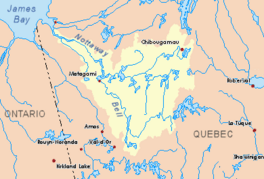Feuquières Lake facts for kids
Quick facts for kids Feuquières Lake |
|
|---|---|

Watershed of Nottaway River
|
|
| Location | Eeyou Istchee James Bay (municipality) |
| Coordinates | 49°12′14″N 74°17′27″W / 49.20389°N 74.29083°W |
| Type | Natural |
| Primary inflows | Outlet of Lake Salk, outlet of Daniel Lake, outlet of lakes Haro and Cardinal, Titipiti River. |
| Primary outflows | Outlet of Feuquières Lake downstream to Robert Lake (Opawica River tributary). |
| Basin countries | Canada |
| Max. length | 12.7 kilometres (7.9 mi) |
| Max. width | 3.0 kilometres (1.9 mi) |
| Surface elevation | 392 metres (1,286 ft) |
Feuquières Lake is a freshwater lake located in the southeastern part of Eeyou Istchee James Bay (municipality) in Quebec, Canada. This area is known as Jamésie in the administrative region of Nord-du-Québec.
The lake stretches across the Feuquières and Robert townships. The main activity around the lake is forestry, which means cutting down trees for wood. After that, people enjoy tourism and recreation, like visiting for fun.
You can reach Feuquières Lake by forest road R1032, which runs north-south on the west side of Gabriel Lake. Another road, Route 167, passes to the east, following the Normandin River. This road connects the towns of Chibougamau and Saint-Félicien, Quebec.
The lake usually freezes over from early November until mid-May. However, it's generally safe to travel on the ice from mid-November to mid-April.
About Feuquières Lake
Feuquières Lake is located about 1.4 kilometres (0.87 mi) west of the border between Saguenay-Lac-Saint-Jean and Eeyou Istchee Baie-James (municipality).
The lake is 12.7 kilometres (7.9 mi) long and has a maximum width of 3.0 kilometres (1.9 mi). It sits at an elevation of 392 metres (1,286 ft) above sea level. Feuquières Lake has many bays, peninsulas (pieces of land almost surrounded by water), and islands.
Three long peninsulas extend from the north shore towards the center of the lake. One is 5.6 kilometres (3.5 mi) long, another is 2.0 kilometres (1.2 mi) long, and the third is 4.2 kilometres (2.6 mi) long. Because of these peninsulas, the lake looks a bit like a fork pointing north.
The Titipiti River, coming from the south, is the main river that flows into Feuquières Lake. Another important river that feeds the lake is the outlet from Salk Lake, which comes from the northeast.
The water from Feuquières Lake flows out from a bay in the northwest. This outlet leads to Robert Lake.
Nearby Places
The mouth of Feuquières Lake is located:
- 20.0 kilometres (12.4 mi) southeast of the mouth of Gabriel Lake
- 13.8 kilometres (8.6 mi) southeast of Rohault Lake
- 55.1 kilometres (34.2 mi) southeast of the mouth of Caopatina Lake
- 83.7 kilometres (52.0 mi) southeast of downtown Chibougamau
- 84.1 kilometres (52.3 mi) southeast of the village center of Chapais, Quebec
- 77.0 kilometres (47.8 mi) west of lac Saint-Jean
- 92.1 kilometres (57.2 mi) north of Gouin Reservoir
- 24.1 kilometres (15.0 mi) northeast of [Obedjiwan] village center
The main rivers and lakes near Feuquières Lake include:
- North side: Rohault lake, Bouteroue Lake, Nemenjiche River, Nemenjiche Lake, Nicabau Lake
- East side: Salk Lake, Finbar Lake, Normandin River, Marquette River West, Poutrincourt Lake
- South side: Queue de Castor River, Ventadour River, Titipiti River
- West side: Cawcot River, Opawica River, Robert Lake, Gabriel Lake, Surprise Lake (Roy River)
Naming the Lake
The name "Feuquières Lake" honors Isaac de Pas, the Marquess of Feuquières (1618-1688). He was a colonel in the army and a lieutenant general. He also served as the viceroy of New France from August 30, 1660, to October 5, 1661.
The name "Lac Feuquières" was officially recognized on November 2, 1956, by the Quebec Geography Commission, which is now called the Commission de toponymie du Quebec. It was officially confirmed on December 5, 1968, when the Commission was created.


